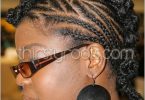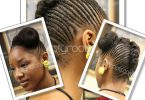If you have ever wondered how many different styles for cornrows there might be, you could be in for a real surprise. That’s because cornrow styles are truly versatile and endless. If you can imagine it, you can probably make it happen, within the realm of hairstyling, of course.
Cornrows are actually quite an ancient tradition. Evidence of this technical hairstyling approach dates back as far as 500 B.C. as seen on hieroglyphs and sculptures in Africa, Nigeria, and Egypt. In fact, one of the most famous sculptures in all of history, the great Sphinx, apparently has cornrow like braids lining the back of its head.
In order to make cornrows, the basic method is to begin a tight braid close to the scalp and follow an underhand, upward motion. When done properly, it will produce almost rope like strands of hair that forms rows on the scalp, hence the name. Of course, this is only the beginning and you can design many different other shapes or styles from here.
In fact, that seems to be one of the purposes of the cornrow hair style. In ancient civilizations it was very common to see particular tribes, groups, or families with a similar hair style. The conclusion, then, would be that these hairstyles were used to distinguish each group from another.
While this was indeed very popular during those times, the cornrow hairstyle is more about personal expression and cultural identity today. The first time that this type of hairstyle started to become popular in modern day was after the Black Pride and Civil Rights movements when there was a deep longing for connection with African roots. Because of this, more African Americans chose to wear more traditionally tribal, natural hairstyles in order to express their personal convictions.
This was very important as blacks tried to forge an identity in America. Over time, though, African hairstyles became more of an art form and professionals stylists were sought be people all over the country for an authentic and intimate traditional hairstyle. While it can cost hundreds of dollars and take up an entire afternoon, it is often worth it because you can leave these hairstyles in for up to a month. Of course, you would have to wash and condition your hair too, but not necessarily using any complicated methods or products. You might want to add some oil to the hair and scalp, though, just to prevent drying, but that’s about it.






